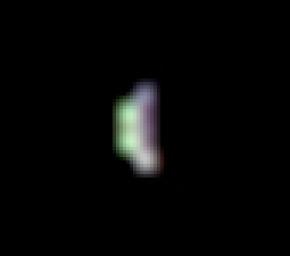Three days after the Mars Reconnaissance Orbiter's Aug. 12, 2005, launch, the NASA spacecraft was pointed toward Earth and the Mars Color Imager camera was powered up to acquire a suite of color and ultraviolet images of Earth and the Moon. When it gets to Mars, the Mars Color Imager's main objective will be to obtain daily global color and ultraviolet images of the planet to observe martian meteorology by documenting the occurrence of dust storms, clouds, and ozone. This camera will also observe how the martian surface changes over time, including changes in frost patterns and surface brightness caused by dust storms and dust devils.
The purpose of acquiring an image of Earth and the Moon just three days after launch was to help the Mars Color Imager science team obtain a measure, in space, of the instrument's sensitivity, as well as to check that no contamination occurred on the camera during launch. Prior to launch, the team determined that, three days out from Earth, the planet would only be about 4.77 pixels across, and the Moon would be less than one pixel in size, as seen from the Mars Color Imager's wide-angle perspective. If the team waited any longer than three days to test the camera's performance in space, Earth would be too small to obtain meaningful results.
The images were acquired by turning Mars Reconnaissance Orbiter toward Earth, then slewing the spacecraft so that the Earth and Moon would pass before each of the five color and two ultraviolet filters of the Mars Color Imager. The distance to Earth was about 1,170,000 kilometers (about 727,000 miles).
This image shows a color composite view of Mars Color Imager's image of Earth. As expected, it covers only five pixels. This color view has been enlarged five times. The Sun was illuminating our planet from the left, thus only one quarter of Earth is seen from this perspective. North America was in daylight and facing toward the camera at the time the picture was taken; the data from the camera were being transmitted in real time to the Deep Space Network antennas in Goldstone, California.

 Planetary Data System
Planetary Data System












